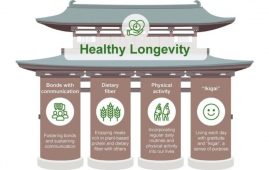

In order to detect dietary nutrient gaps by demographics, researchers have modeled the global prevalence of low micronutrient intakes for 15 essential micronutrients. Their findings were published in The Lancet Global Health.
Context
Worldwide, micronutrient deficiencies are a major health risk. It affects essential elements like iodine, iron, zinc, folate, and vitamin A and raises morbidity and death. The scope and demographic specificities of this issue are yet unknown, nevertheless, because of a lack of data.
Micronutrient deficiencies and inadequate nutrient supply have been studied; worldwide estimates of micronutrient consumption insufficiency, however, have received little attention.
Clinical nutritional biomarkers evaluate the global incidence of micronutrient deficits; geographically, demographically, and for specific micronutrients, there are data gaps. Previous estimates of micronutrient adequacy are inaccurate because they do not take into consideration food waste from homes, restaurants, small-scale farming, and wild harvesting.
About the Study
Researchers give global estimates of inadequate dietary micronutrient intakes in this study, broken down by gender and age.
The researchers looked at data on dietary intake from 31 different countries, including information at the individual and nutrient levels, two or more days’ worth of food consumption, and information from 24-hour recalls, diet records, or food diaries for more than 200 people.
They applied the anticipated median consumption of micronutrients for various age-gender groups from 185 countries using globally harmonized gender- and age-specific nutritional data from the Global Dietary Database (GDD).
By calculating the distribution size (i.e., median intake) from the Global Dietary Database (GDD) and the distribution shape (i.e., intake variabilities) using nutriR data, the researchers were able to generate subnational nutrient consumption distributions. The GDD’s 2018 forecasts indicated that 7.6 billion people, or 99% of the global population, would suffer from nutritional deficiencies.
The researchers compared predicted micronutrient intakes to the distributions of dietary requirements using probability methods to determine the prevalence of intake inadequacy. They evaluated nutritional deficiencies across 17 age groups—0 to 80 years old in five-year intervals and an individual group of men and women aged 80 years or older—using World Bank estimates of the human population. Based on data, researchers matched each subnational group to the shape features of the subnational group that was most comparable.
Two micronutrients were removed from the study by the researchers: potassium, for which there is no known average required level, and D vitamin, whose distribution varies greatly by area because sun exposure can meet the mean requirement instead of food consumption. They made the assumption that everyone drinks an appropriate amount of water each day, which is 16 mg of magnesium and 46 mg of calcium per liter, in order to account for the nutrient supply in drinking water.
Consequences
Major global nutritional deficiencies are identified by the study, particularly in the areas of vitamin E, iodine, calcium, iron, folate, and riboflavin. Most people don’t get enough micronutrients in their diets. Recognizing these trends can assist in identifying areas that require nutritional interventions, such as supplements, diet adjustments, and biofortification.
The efficiency of delivering interventions can be improved by correlating inadequacies in nutritional intake. Public health professionals may find the study’s conclusions useful in developing targeted nutrition programs and regulations. Before fortification, supplementation, and dietary intervention measures are implemented in particular regions, further research is needed to determine the causes and extent of deficiencies.
For more information: Global estimation of dietary micronutrient inadequacies: a modelling analysis, The Lancet Global Health, https://doi.org/10.1016/S2214-109X(24)00276-6
more recommended stories
 Cardiovascular Risk and Sudden Cardiac Death in Diabetes
Cardiovascular Risk and Sudden Cardiac Death in DiabetesRising Sudden Cardiac Death (SCD) Risk.
 Perinatal Mental Health Challenges Highlighted in New Study
Perinatal Mental Health Challenges Highlighted in New StudyMental Health Challenges in New Parents:.
 Walking Speed Before Hip Replacement Predicts Recovery
Walking Speed Before Hip Replacement Predicts RecoveryNew Evidence Points to a Simple,.
 How Soybean Oil Impacts Weight Gain and Metabolism
How Soybean Oil Impacts Weight Gain and MetabolismWhy Soybean Oil May Affect Metabolism.
 New Malaria Prevention Insights From African Biostatistics
New Malaria Prevention Insights From African BiostatisticsHow New Data Is Reframing Malaria.
 World Summit Outlines Core Principles for Healthy Longevity
World Summit Outlines Core Principles for Healthy LongevityWhy Healthy Longevity Demands a New.
 Gut Immune Cells and Long-Lasting Antiviral Protection.
Gut Immune Cells and Long-Lasting Antiviral Protection.Breakthrough Findings on How Gut Immune.
 Mild Pancreatic Duct Dilatation Signals Higher Cancer Risk
Mild Pancreatic Duct Dilatation Signals Higher Cancer RiskEarly Structural Changes Offer Critical Clues.
 Ultra-Processed Foods in Mediterranean Youth: Risks
Ultra-Processed Foods in Mediterranean Youth: RisksThe Mediterranean region is widely recognized.
 Intensive mind-body retreat rapidly alters brain function
Intensive mind-body retreat rapidly alters brain functionAn intensive mind-body retreat combining meditation,.

Leave a Comment